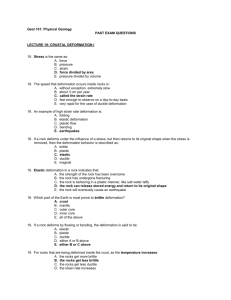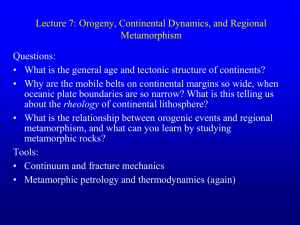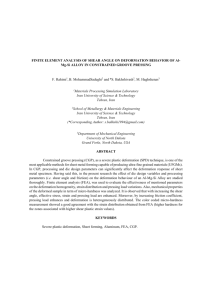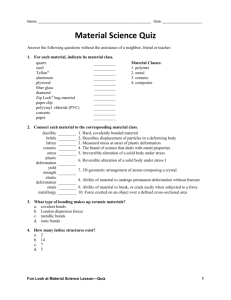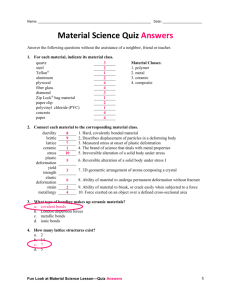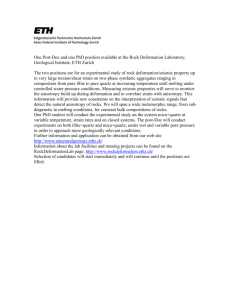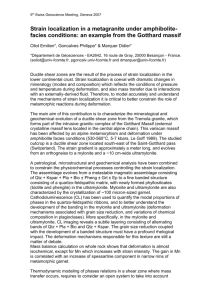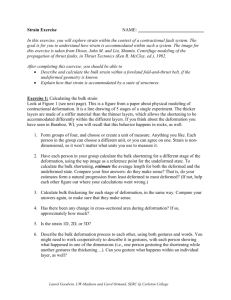Orogeny and Rheology
advertisement
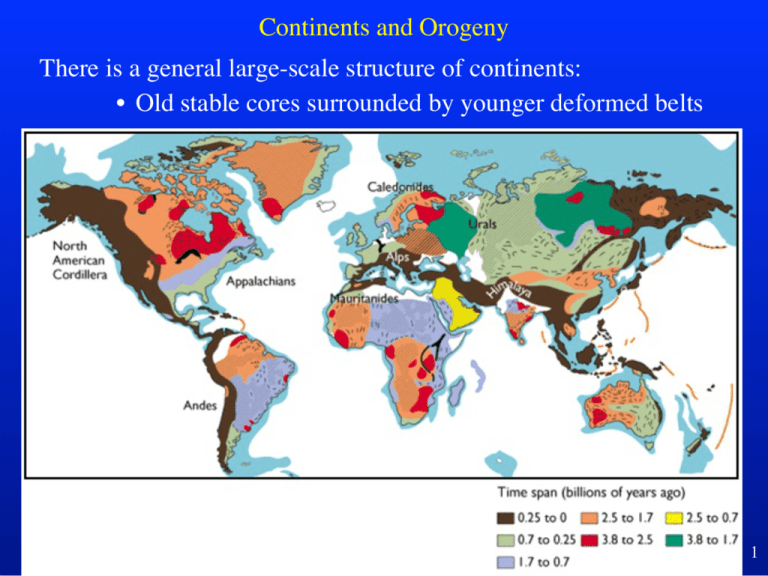
Continents and Orogeny There is a general large-scale structure of continents: • Old stable cores surrounded by younger deformed belts 1 Continents and Orogeny • Each continent has regions in the interior, far from its margins, that have not undergone significant tectonic deformation for a long time. The stable regions, undeformed since precambrian time, are called cratons (particularly if Archean in age). Where precambrian crystalline (i.e., igneous and metamorphic) rocks are exposed over a wide area, that part of the craton is called a shield (example: Canadian shield). • Where the craton is covered by a relatively flat-lying undeformed sequence of paleozoic and later sediments, it is called a platform. Within the platform, there may be roughly circular or oval regions that experienced prolonged subsidence and accumulated thick sedimentary basins. In between basins there may be regions that have long stood relatively high and accumulated little sediment. If roughly linear, these are arches; if roughly circular, these are domes 2 Continents and Orogeny • The rest of continental area is made up of orogenic or mobile belts. These typically bound cratonic regions in the interior of aggregate continents and surround the cratons around most of the margins of each continent, where collisions, subduction, and rifting most often occur. • Near the edges of platforms are found two other types of sedimentary basins that originated as parts of orogenic belts and became incorporated into the craton by later stabilization. These include – orogenic foredeeps formed during orogenic events and filled with sediment shed off an orogenic mountain belt and – passive continental margin sequences (example, Gulf Coast) . 3 Continents and Orogeny • To a certain extent, the distinction between craton and mobile belt is arbitrary, and relates only to the age since the last deformation event. It is nevertheless useful because once a mobile belt is stabilized, it can preserve details of geologic history for very long times. Note this triplejunction here 4 Continents and Orogeny • The rocks making up orogenic belts are a combination of juvenile materials (continental arcs have a major mantle-derived component of new crust) and reworked rocks from older terranes (either by deformation in situ or by erosion and redeposition). One can think of major continental provinces in terms of the age of deformation, rather than the age of the rocks as such (though this will often be the same). Since not all the material in a new mobile belt is new, young mobile belts can be seen to truncate and incorporate parts of older mobile belts. Here it is again 5 Continents and Orogeny • Orogenic belts can be thousands of kilometers wide (examples: HimalayaTibet-Altyn Tagh system; North American cordillera), which shows that the simple plate tectonic axiom of rigid plates with sharply defined boundaries is not that useful in describing continental dynamics. – Really, rigid plate dynamics applies best to oceanic lithosphere only. • Why do continents deform in a distributed fashion over wide zones? Because continental crust and lithosphere are relatively weak. And why is that? We’ll go through the long answer… 6 Rheology at Plate Scale • It is possible to find clear examples where obviously weak mechanical properties of crust contribute directly to distributed deformation, as in this picture of the Zagros fold-and-thrust belt, which is full of salt (the dark spots are where the salt layers have risen as buoyant, effectively fluid blobs called diapirs or salt domes (the image is 175 km across). • Broadly speaking, we can understand the difference between continents and oceans in this regard by considering the strength of granitic (quartz-dominated) and ultramafic (olivine-dominated) rock as functions of pressure and temperature… • This requires us to go into continuum mechanics, which describes how materials deform (strain) in response to applied forces (stress). 7 Continuum Mechanics: stress • Stress is force per unit area applied to a particular plane in a particular direction. Generally (assuming no unbalanced torques), stress is a symmetric second-rank tensor with 6 independent elements: ⎡σ11 σ12 σ13 ⎤ σ = ⎢⎢σ12 σ 22 σ 23 ⎥⎥ ⎢⎣σ13 σ 23 σ 33 ⎥⎦ • The diagonal elements are normal stresses; the off-diagonal elements are shear stresses 8 Continuum Mechanics: stress • We can always find a coordinate system in which the stress tensor is diagonal, which defines the stress ellipsoid, whose axes are the principal stresses σ1, σ2, σ3. – By convention, σ1 is the maximum compressive (positive) stress, σ2 is the intermediate stress, and σ3 is the minimum compressive or maximum tensile (negative) stress. • The trace of the stress tensor is independent of coordinate system and is three times the mean stress: – σm = (σ11+σ22+σ33)/3 = (σ1+σ2+σ3)/3. – IF AND ONLY IF the three principal stresses are equal and the shear stresses are all zero, we have a hydrostatic state of stress and the mean stress equals the pressure. – The stress tensor minus the diagonal mean stress tensor is the deviatoric stress tensor. Differential stress, σ1-σ3, however, is a scalar. 9 Continuum Mechanics: strain • Strain, on the other hand, is the change in shape and size of a body during deformation. We exclude rigid-body translation and rotation from strain; only change in shape and change in size count 10 Continuum Mechanics: strain • Strain is always expressed in dimensionless terms. – So a change in length L of a line can be expressed by ε = ΔL/L. – A change in volume V is expressed as ΔV/V. – A shear strain can be expressed by the perpendicular displacement of the end of a line over its length γ = D/L or by an angular strain tan ψ = D/L. • In general, strain, like stress, is a second-rank tensor (ε) with six independent elements – (in this case the antisymmetric component of deformation went into rotation, rather than the force balance argument for stress). – It can also be expressed by a principal strain ellipse in a suitable coordinate system and be decomposed into volumetric strain and shear strain. • The strain rate, or strain per unit time, is usually expressed ε˙ 11 Continuum Mechanics: constitutive relations • The relationship between stress and strain or strain rate for a material is called the constitutive relation and depends in form on the deformation mechanism and in parameters on the material in question. • Deformation can be either recoverable or permanent. Recoverable deformation is described by a time-independent strain-stress relation – when the stress is removed, the strain returns to zero. This includes elastic deformation and thermal expansion. Permanent deformation includes plastic and viscous flow or creep as well as brittle deformation (faulting, cracking, etc.) and requires a time-dependent constitutive relation (perhaps expressing the relationship between stress and strain rate instead of strain). 12 Continuum Mechanics: constitutive relations • Generally speaking, at low stresses solid materials respond elastically, up to some yield stress where plastic deformation or brittle failure begins. – We usually describe deformation of a fluid-like material with no yield strength as viscous and deformation of a solid above the yield stress as plastic (particular when it is accommodated by motion of dislocations in the solid lattice). – Seismology is all about elastic deformation below the yield stress; geology, on the other hand, is all about permanent deformations, plastic or brittle. • The constitutive relationship for elastic deformation is Hooke’s Law: strain is proportional to stress. For a simple one-dimensional spring, this is F = –kx. For a general three-dimensional material, σ ij = Cijklε kl where the fourth-rank elasticity tensor C has, for the most general material, 21 independent elements. For a material that is isotropic, i.e. its properties are independent of direction or orientation, there are only two independent elasticity parameters. Several different choices are made of which two to use, but popular ones are (Bulk Modulus K and Shear Modulus µ) or (Young’s modulus E and Poisson’s ratio ν). 13 Continuum Mechanics: constitutive relations • The constitutive relation for simple Newtonian viscous flow is σ = ηε˙ where η is the viscosity (which usually has an Arrhenius relationship to temperature: lnη ∝1/T ). • For plastic deformation of solids, there are two broad classes of € creep: € – dislocation creep, accommodated by motion of defects through the crystals, which tends to follow a power law, e.g., −Q⎞ 3 ⎛ ε˙ = Coσ exp⎝ ⎠ RT – diffusion creep, which often uses grain boundaries to move material around and so depends on the grain size of the rock: Dσ ⎛ −Q⎞ , n = 2 or 3 exp ⎝ RT ⎠ dn – At any particular condition, fastest mechanism dominates, so dislocation creep takes over at high stress. 14 ε˙ = Co Continuum Mechanics: Plastic strength of rocks • For our purposes, the key aspect of these laws is the exponential temperature dependence of plastic strength (differential stress σ1-σ3 at a given strain rate), and the preexponential terms which differ from one mineral to another. NOTE: olivine is strong, quartz and plagioclase are medium, salt is very weak 15 Continuum Mechanics: Brittle Failure • To complete a first-order understanding of the strength of crust and lithosphere, we need to venture into brittle rheology and fracture mechanics (briefly). • Whereas plastic flow is strongly temperature dependent (weaker at high T), brittle deformation is strongly pressure dependent (stronger at high P), since (1) most crack modes effectively require an increase in volume and (2) sliding is resisted by friction, which is proportional to normal stress. • Preview: since P and T increase together along a geotherm, any rock will be weaker with regard to brittle deformation at the surface of the earth and weaker with regard to plastic flow at large depth; the boundary between these regimes is called the brittle-plastic or brittle-ductile transition. Whichever mode is weaker controls the strength of the rock under given conditions. 16 Continuum Mechanics: Brittle Failure • To talk about fracture strength, we need the all-important Mohr Diagram, which is a plot of shear stress (στ) vs. normal stress (σn) resolved on planes of various orientations in a given homogeneous stress field. cosΘ • Start with two dimensions. Consider a plane of unit area oriented at an angle Θ to the principal stress axes σ1 and σ2. At equilibrium, force (not stress!) balance requires: σ2 σ1 cosΘ = σ n cosΘ + στ sin Θ σ 2 sin Θ = σ n sin Θ − σ τ cosΘ στ σn Which we can solve for σn and στ: σ1 σ1 1 Θ sinΘ σ2 σ1 + σ 2 σ 1 − σ 2 σn = + cos2Θ 2 2 σ1 − σ 2 στ = sin 2Θ 2 17 Continuum Mechanics: Brittle Failure σ + σ 2 σ1 − σ 2 σ −σ2 σn = 1 + cos2Θ στ = 1 sin 2Θ 2 2 2 • This is the equation of a circle in the (σn, στ) plane – with origin at ((σ1+σ2)/2, 0) – And diameter (σ1–σ2) • Note: (σ1+σ2)/2 is the mean stress, and (σ1–σ2) is the differential stress! • If we plot the states of stress resolved on planes of all orientations in two dimensions for a given set of principal stresses, then we get a Mohr Circle: +στ (clockwise) (σn,στ ) (σ2,0) -σn (tension) [σ 1-σ2] 119.2° 2Θ 2 ([σ1+σ2]/2,0) (σ1,0) +σn (compression) Mohr circle −στ (anticlockwise) 18 Continuum Mechanics: Brittle Failure • In three dimensions, all the possible (σn, στ) points lie on or between the Mohr circles oriented in the three principal planes defined by pairs of principal stress directions +στ (clockwise) (σ3,0) −σn (tension) −στ (anticlockwise) (σ2,0) (σ1,0) +σn (compression) Shaded area is locus of stresses on planes of all orientations in 3-D • So what? Well, experiments that break rocks show that the fracture criteria can be plotted in Mohr space also. The result is a boundary called the Mohr Envelope between states where the rock fractures and states where it does not. The Mohr envelope shows both the conditions where fracture occurs and the preferred orientation of fractures relative to σ1. 19 Continuum Mechanics: Brittle Failure For σ1 ≥ ~5To, (To= tensile strength) many rocks follow a Coulomb fracture criterion, a linear Mohr envelope at positive σ1. In the Earth overburden pressure means σ1 is always compressive. Coulomb fracture is defined by |στ| = So + σntanφ where So is the shear strength at zero normal stress (aka cohesive strength) and φ is the angle of internal friction. An empirical modification is Byerlee’s Law, a two-part linear fracture envelope. Another common behavior is the Griffith criterion, which is a parabolic Mohr envelope. The bottom line of Coulomb fracture behavior for our purposes is that is shows that the fracture strength of rocks increases (~linearly) with mean stress or effective pressure (why effective pressure? Because pore pressure pushing out on the rock exerts a negative effect on mean stress and therefore weakens the rock). 20 Continuum Mechanics: Overall Strength envelopes • If we map the temperature-dependent plastic strength and the pressuredependent brittle strength of rocks onto a particular geotherm (i.e. temperature-depth curve), we have a prediction of the strength of the crust and lithosphere as a function of depth. • For the oceanic case (6 km of basaltic crust on top of olivinerich mantle) and the continental case (30 km of quartz-rich crust on top of olivinerich mantle), it looks like this: 21 Continuum Mechanics: Conclusion • So, why are oceanic plates rigid but continents undergo distributed deformation? • Because continental crust is thick and quartz has a weak plastic strength. Although the thermal gradient in continents is lower, and at large depth the lithosphere is colder and stronger, what really matters is that we do not encounter olivine, which is strong in plastic deformation, until larger depth and therefore much higher temperature under continents. • We can also understand how strain concentration to plate boundaries works: – Mid-ocean ridges are weak because adiabatic rise of asthenosphere brings the hot, weak plastic domain almost to the surface; the brittle layer is only ~2 km thick – Subduction zones may be weak because high fluid pressures lower the mean stress across their faults and promote brittle behavior to large depths. 22 Regional Metamorphism • One major consequence of continental deformation is regional metamorphism. – Orogenic events drive vertical motions and departures from stable conductive geothermal gradients. Shallow crust is deeply buried under nonhydrostatic stress and undergoes coupled chemical reaction and ductile deformation. The same event at later stages may uplift deep crust into mountain ranges where erosion can unroof it for geologists to view. – Generally, in map view the surface will expose rocks of a variety of metamorphic grades (i.e., peak P and T), either because of differential uplift or because igneous activity heated rocks close to the core of the orogeny. The sequence of metamorphic grades exposed across a terrain is called the metamorphic field gradient and is characteristic of the type of orogeny. • we have already seen the blueschist path of low-T, high-P metamorphism leading to eclogite facies, associated with the forearc of subduction zones. • In the arc itself, the dominant process is heating by large scale igneous activity, and we see a relatively high-T path leading to granulite facies. • In collisional mountain belts, burial is dominant and what results is an intermediate P-T path called the Barrovian sequence 23 Regional Metamorphism: Facies and Zones • Metamorphic conditions can be defined by zones, the appearance or disappearance of particular minerals in rocks of a given bulk composition. The line on a map where a mineral appears is called an isograd, and ideally expresses equal metamorphic grade. Thus, along a field gradient in pelitic rocks (Al-rich metasediments, from shaly protoliths), Barrow defined the following sequence of isograds, which corresponds to a particular P-T path in experiments on phase stability in pelitic compositions. 24 Regional Metamorphism: Facies and Zones • However, in different bulk compositions, the same mineral (though probably of different composition if you go to the trouble of a microprobe analysis) appears under different conditions, so zones are not very general: – a mineral isograd recognizable in the field is not necessarily a surface of constant metamorphic grade. Pelitic Rocks Basaltic Rocks 25 Regional Metamorphism: Facies and Zones • This leads to the concept of a metamorphic facies, which is meant to express a given set of conditions independent of composition. Confusingly, however, the facies are generally named for the assemblage typical of basaltic rocks equilibrated at the relevant conditions. Facies are bounded by a network of mineral reactions. 26 Mineral reactions and geothermobarometry • Some mineral reactions precisely indicate particular P-T conditions, especially those involving pure phases. – Thus: the andalusite-kyanite-sillimanite triple point and univariant reactions are based on the stable structures of the pure aluminosilicate (Al2SiO5) phases. No other constituents dissolve in these minerals, so nothing except kinetics affects the reactions. • Most reactions involve phases of variable composition and hence it is necessary to measure phase compositions and use thermodynamic reasoning to interpret the results in terms of P and T. – A metamorphic assemblage can be bracketed into a given region of P-T space using the mineral reactions that bound the stability of the observed assemblage. Continuous mineral reactions involving solutions are used to quantify T or P. – A reaction that is very T-sensitive and relatively P-insensitive makes a good geothermometer. A reaction that is P- sensitive and relatively Tinsensitive makes a good geobarometer. A combination of (at least) two such reactions yields a thermobarometer, an estimate of T and P. 27
